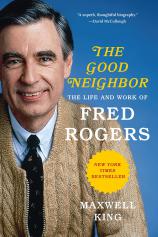The Good Neighbor: The Life and Work of Fred Rogers
Review
The Good Neighbor: The Life and Work of Fred Rogers
Fred Rogers grew up in privilege, disliked television when he first watched it, and created a fictional neighborhood that set the standard for tasteful, developmentally sound children’s viewing.
Maxwell King's biography portrays Rogers as a hard fellow to dislike, partly because of a lifelong habit of keeping his opinions to himself. Raised in the town of Latrobe, Pennsylvania, he was the son of successful, wealthy parents and grew up in a mansion, with a cook and chauffeur on staff. His mother showered affection on him while keeping her rather delicate, asthmatic boy in a state of isolation, making him initially a shy, nerdy child. But by high school he was a leader, editor and actor. After a short stint at Dartmouth, known for its hard partying, the devout, studious Rogers transferred to a music program at Rollins College. There he met his future wife and began to bloom as a composer and performer who one day would write and sing his famous theme song, “It’s a Beautiful Day in the Neighborhood.”
"THE GOOD NEIGHBOR will open the door to many memories of the odd, gentle, sincere and enormously popular man behind the beloved series..."
When Rogers saw his first TV program, he was simultaneously “appalled” and “attracted” to such an extent that he deferred his plan to go into the Presbyterian ministry in favor of a career in educational television, convinced he could turn the new medium to some good purpose. As a puppeteer, musician and program director in the early days of NBC, he started a one-hour children’s show that eventually led to his association with PBS in Pittsburgh and the 33-year run of “Mister Rogers’ Neighborhood.”
King, the CEO of the Pittsburgh Foundation, has created this portrait of the smiling man in the sweater from interviews with family, friends and co-workers. Some religious colleagues saw him as a prophetic personality, almost Christ-like in his dedication to his work. Yet Rogers himself, Maxwell records, always emphasized the human side of Jesus, seeing him as embodying typical, attainable virtues. On his show Rogers was an innovator, once interviewing a disabled boy by asking him about the mechanics of his wheelchair. His program was said to have a calming, focusing effect on its young viewers, rather remarkable even for the less frantic era it spanned. It advertised no product and seemed, like Rogers himself, to revel in quiet study.
As revealed in interviews with his sons, Rogers the parent comes across as both liberal, expecting his sons to exercise self-discipline, and conservative, limiting their TV watching time. He himself was highly disciplined, swimming routinely up until a few weeks before his death.
2018 marks the 50th anniversary of “Mister Rogers’ Neighborhood.” THE GOOD NEIGHBOR will open the door to many memories of the odd, gentle, sincere and enormously popular man behind the beloved series, and invite us to weigh the show’s intentions and impact against other kinds of viewing now available to young children.
Reviewed by Barbara Bamberger Scott on September 7, 2018
The Good Neighbor: The Life and Work of Fred Rogers
- Publication Date: September 17, 2019
- Genres: Biography, Entertainment, Nonfiction, Performing Arts
- Paperback: 416 pages
- Publisher: Abrams Press
- ISBN-10: 1419735160
- ISBN-13: 9781419735165



